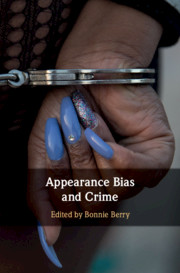Book contents
- Appearance Bias and Crime
- Appearance Bias and Crime
- Copyright page
- Dedication
- Epigraph
- Contents
- Biographical Sketches of Contributors
- Acknowledgments
- Introduction
- Part I Unattractiveness, Criminality, and Victimization
- Part II Race, Ethnicity, and Nationality as Targeted Identities
- Part III The Process of Social Control as Influenced by Appearance
- Part IV Identifying Terrorists, Mistakenly or Not, by Appearance
- Part V Very Visible Differences
- Conclusion
- Index
- References
Part II - Race, Ethnicity, and Nationality as Targeted Identities
Published online by Cambridge University Press: 22 March 2019
- Appearance Bias and Crime
- Appearance Bias and Crime
- Copyright page
- Dedication
- Epigraph
- Contents
- Biographical Sketches of Contributors
- Acknowledgments
- Introduction
- Part I Unattractiveness, Criminality, and Victimization
- Part II Race, Ethnicity, and Nationality as Targeted Identities
- Part III The Process of Social Control as Influenced by Appearance
- Part IV Identifying Terrorists, Mistakenly or Not, by Appearance
- Part V Very Visible Differences
- Conclusion
- Index
- References
Summary

- Type
- Chapter
- Information
- Appearance Bias and Crime , pp. 63 - 124Publisher: Cambridge University PressPrint publication year: 2019



